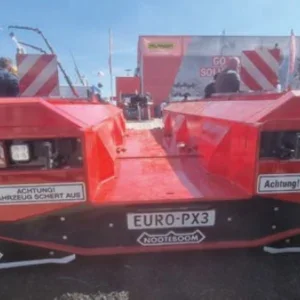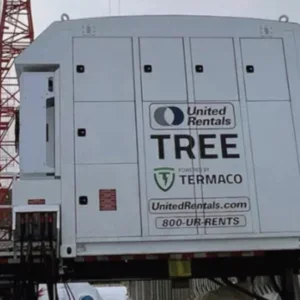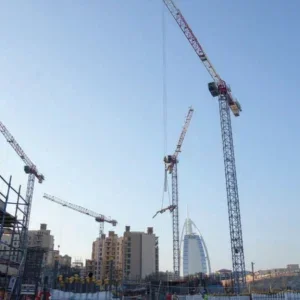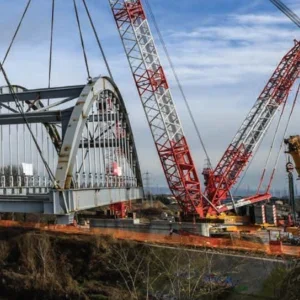Just a couple of years ago demand for boom trucks was at rock bottom. This year and next, sales are expected to be close to peak levels as owners replenish their fleets.
Boom trucks are the American version of simple truck-mounted telescopic cranes, sometimes with enclosed operator cabs but more often an open seat or stand up controls, particularly on smaller models. Though there are some sales into Latin America, the dominant market is North America where they are used in a range of industries. They can be seen erecting steel, power lines or advertising signs, among many other things.
At peak, the North American market will take up to 2,400 units a year. In 2003 just 1,400 new boom trucks were sold. By the time the 2005 numbers are worked out, it is expected the figure will easily clear 2,000.
The market leader remains National, a subsidiary of Manitowoc Crane Group since its acquisition of Grove in 2002. Its closest rivals are Terex and Manitex. Manitex, now owned by a venture capitalist group, used to be part of the Manitowoc family but the US anti-trust authorities forced a disposal when Manitowoc acquired National. At the time, it was felt a merger of two of the big three would create an anti-competitively large force, especially as Manitex had recently acquired USTC and Pioneer. That decision may not have been reach in the current market, however, because three significant new entrants have since broken into the market – Altec, Elliott Equipment and Tadano.
The entry into this market of Altec, a major US producer of utility equipment such as digger derricks and truck-mounted aerial work platforms, was covered in detail in the April 2004 issue of Cranes Today.
Elliott Equipment, another established producer of truck-mounted aerial work platforms, began producing boom trucks in 2003. Its first model was the 1870, rated at 18 US ton capacity and with 70ft (21.3m) of boom. Elliott president Jim Glazer says the decision to enter the market was prompted by the consolidation that had taken place in the market, reducing the field to just the three main players. Since its entry, Elliot has expanded its range to models of 10, 24, 28 and 32 US ton capacity, with three different booms for each size. The 32 ton model is also available with a swing cab and 105ft (32m) of boom.
“There’s more to come,” Glazer says. “We’ll have further developments in the next 18 months.”
Features of Elliott boom trucks include smooth controls and a ride-around viewing platform to enable the operator to keep sight of the load. The boom pivot pin is mounted high on the turret, a geometry that gives extra power, Glazer explains.
Says Glazer: “We have been very successful. People are very excited in the field about our designs and our approach to the business, as a family-owned company.”
Tadano’s entry to the boom truck market follows an initial launch of its Japanese-style telescopic boom loader cranes. At Conexpo 1999 it showed the 7,000 lb (3t) capacity TM-ZR300XL, available with boom lengths of 22ft, 29ft and 35ft.
The 10,000 lb (4.5t) capacity TM-ZR500XL followed, with four boom lengths of 27ft, 35ft, 43ft and 51ft.
In 2004 it launched the 20,000 lb (9t) capacity model TM-1052 with a 52ft five-section boom, converted to North American style operating levers. All models have 360 degree continuous rotation, out and down outriggers and computerised load monitoring.
In May 2004 came the TM-1882, rated at 18 US ton capacity and with 82ft (25m) of boom. Within 18 months Tadano America Corporation had sold 100 units of the TM-1882.
Hidetoshi Iga, manager of Tadano America Corporation’s boom truck division, explains how and why Tadano moved from offering its cargo cranes to developing a product specifically for the US market. “In 2002 Tadano recognised a market that was not being satisfied by the North American boom truck manufacturers,” says Iga.
He continues: “The truss manufacturers in Northern California needed a long boom crane with good capacities as well as a short retracted length. The overall length of tractor/trailer loads are restricted by Californian highway regulations. Tadano design engineers made several trips to the truss industry members in California and came up with a set of design parameters. The TM-1882 was introduced to the truss industry in Sacramento, California in 2004 with assistance from Coast Crane Company.”
Iga claims that the TM-1882 has “all the features needed to fill a gap that had been overlooked by other crane manufacturers – an 18 ton capacity tractor-mounted unit with a six-section 82ft telescopic boom with exceptional speed, out and down outriggers with reduced span capacities, and lighter weight for fuel economy.”
Key to the success of the TM-1882 is that the boom does not hang over the front, since Californian regulations restrict the length of tractor and trailer units to 45ft if there is an overhang. Without an overhang, they can be up to 60ft long.
“Extremely fast set-up and a no overhang travel configuration gave the market a way to haul the longer trusses required for modern house construction without the need for multiple support vehicles or oversize load permits,” Iga claims.
With a boom truck dealer network now taking shape, Tadano is planning further product development to develop a full product line.
The timing of the newcomers appears good. They joined at the bottom of the market and are ready to take their share of the market now that it has swung back up. The three established players, however, continue to dominate the market presently.
Randy Robertson, director of sales and marketing at Manitex, confirms that demand is hot right now. “To say business is good is an understatement,” he says. “The boom truck market is at height of recovery. All markets served by Manitex are very active and the outlook for 2006 remains strong. Customers remain in the fleet replacement cycle and have not begun to replenish inventories.”
Robertson explains that his dealers are trying to build up their rental fleets but everything they take from the factory is immediately being sold to end users. He expects 2006 to be “another strong year too”.
Manitex has introduced three new models in 2005. The SC85 is a combination crane/work platform aimed at the outdoor advertising and sign erection sector. It lifts a maximum of 12 US tons at 5ft radius and has a 70ft three-section boom.
For oil field applications Manitex has launched the trailer-mounted 2892CH, which lifts 28 US tons at 5ft and has A-frame main outriggers and out and down ones at the front. It has a 90ft four-section full power boom. Robertson explains that trailer-mounted cranes allow for higher payload capacities, while placing the crane at the rear of the trailer positions it closer to the lift and reduces the amount of equipment needed on small oilfield work sites.
For the same industry is the new Manitex 1770WL, a 17 US ton crane with a 70ft three-section boom, mounted at the rear of the truck chassis. It has two hoists: a 12,000 lb grooved drum main hoist and a 4,000 lb auxiliary hoist for rigging oil field tooling and logging equipment.
For cross-country power line construction is Manitex’s 102SX, a 30 US ton capacity model with a 102ft four-section boom and X-style outriggers. The 102SX is the second in the SX series, following the introduction of the 124SX in 2004. “Both cranes were designed to meet the needs of the cross country power line construction contractors, where higher ground clearance is needed to travel over rough terrain,” Robertson explains. They also come with the option of a rotating man basket for tower construction.
National, the market leader, has also introduced several new models this year. Conexpo saw the show debut of the 690E, the longest of the five models in the 600E series that was introduced in 2004. The 690E is rated at 20 US tons (18t) has an 80ft (27.4m) four-section boom. An optional two-section jib offers additional reach between 25ft and 45ft (7.6m and 13.7m), giving a maximum tip height of 144ft (44m).
The 9125E, another Conexpo launch, is the longest reaching of the four models in the 900A series. With 125ft (38.1m) of boom, it is a long-boom version of the 9103A (103ft boom) for applications where additional reach is required. A particular market for this model is wireline support work in oilfields. Wireline support requires a long cylinder to be lowered down a live oil well with a wire feed down the middle to record data on the well. With higher pressure wells reaching over 41,000 kN/m2 (6,000 psi) pressure, longer and larger cylinders are needed for wireline work, hence the need for cranes with bigger booms.
More recently, in September, National launched another two models at the ICUEE show in Louisville, Kentucky. The 1300A lifts 30 US tons (27t) at 5ft (1.5m) radius and is a successor to the 1300 series. At ICUEE it was shown as a 13100A, which has a 100ft (30m) four-section boom. It is also available with a 110ft (34m) boom, which together with an optional jib gives a maximum tip height of 162ft (49m). The outriggers are H-style and can be partially as well as fully deployed. New for this crane is the use of the Vision cab, as seen on other Manitowoc Crane Group models.
Optional features include a Work Area Definition System (WADS) on the load moment indicator.
John Lukow, vice president of sales at National Crane, says: “We chose to launch the 1300A at this year’s ICUEE because it is ideal for utility and construction companies. It is a fast, dependable lift solution that takes only a few minutes to erect once the truck is positioned. It’s a perfect candidate for jobs such as sign work, roofing, and building erection.”
Surely the greatest innovation in the boom truck sector this year, however, has to be the ENVI 690EU from National – the world’s first “green” crane.
“The ENVI is not merely an industry first, it is a pioneering machine,” claims Manitowoc Crane Group president Glen Tellock.
It has basically the same specifications as the 690E except for the fact that both the diesel that powers it and the fluid in its hydraulics are biodegradable. This is not a first for the construction machinery industry, but according to Manitowoc is a first for cranes.
The EnviroLogic biodiesel and hydraulic fluid, produced by Terresolve, are made from vegetables such as soybeans, sunflowers and corn. The use of such biodegradable fuels and oils is particularly attractive for applications in environmentally sensitive locations or where any leaks of conventional petroleum-based products would present a safety hazard. Bio fluids, as used in the ENVI, have a lower toxicity rating than petroleum-based products and, in the event of leakage or spillage, they break down into harmless compounds much more quickly. Terresolve also claims reductions in maintenance costs.






